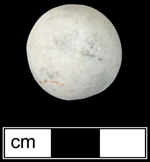Stone Marbles
Click images for larger view.
Federal Reserve Site (18BC27)

-stone-sm.jpg)

-stone-sm.jpg)
Smith St. Leonard (18CV91)

Limestone marble.
didn’t begin until after 1769 (Gartley and Carskadden 1998:93).
Since occupation at this site dated circa 1711-1749, this artifact represents an early example of
a limestone marble in the American colonies.
Queenstown Courthouse (18QU124)
-stone-sm.jpg)

-stone-sm.jpg)
-stone-sm.jpg)
Naturally colored grey and yellow limestone marbles.
Naturally colored yellow
limestone dyed with brown
(manganese).
being dyed in solid colors by the 1880s, but perhaps as early as the 1850s (Gartley and Carskadden 1998:101).
Gartley and Carskadden also note that archaeologically-recovered examples of dyed limestone marbles are often
quite faded, as is with the example shown on far right. North America really didn’t begin until after 1769 ( Gartley
and Carskadden 1998:93).